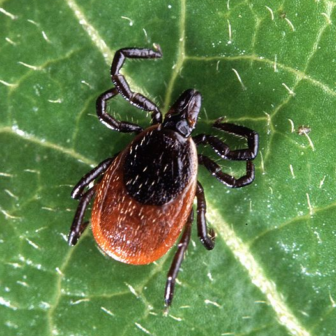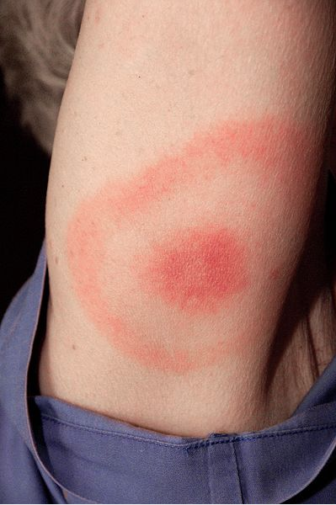The black legged or deer tick (Iodes scapularis) is well known for spreading Lyme disease. Now, after a very mild winter, there are reports of a large number of ticks, all looking for a blood meal, possibly from you!
_____________
— an announcement from Darien Health Department
_____________
Here are some tips and things to know to protect yourself and your family:
LYME DISEASE PREVENTION

Photo by Scott Bauer for U.S. Department of Agriculture
Adult deer tick, “Ixodes scapularis”
Residents can bring ticks taken from themselves or family members (no dog ticks please!) to the Health Department office where they will submitted and tested for the bacteria that cause Lyme Disease.
While waiting for the results, watch for any of the following symptoms of Lyme Disease:
* Flu-like feeling, aches, fever, headache
* Enlarging often “bull’s eye” rash at the original site of the bite; reddish on light skin, bruised looking on darker skin. About 50 percent of light skinned adults get a rash and some get multiple rashes. Joint swelling or pain may also occur.
If any of the above symptoms occur, notify your physician. Also, you must be aware of the fact that symptoms of Lyme Disease can vary between patients so it is important that your physician be aware of your activities and potential exposure to ticks.
TICK FACTS
* A tick must be attached to the skin for at least 24 hours to become completely engorged which also is the minimum amount of time it takes for disease transmission to occur.
* Ticks are second only to mosquitoes as transmitters of infectious agents to humans. The longer an infective tick is permitted to feed, the greater chances of transmitting the infection.
* Ticks are external bloodsucking parasites that feed on humans or other mammals. They are entirely dependent on blood or tissue fluids for life.
* A tick seeks a blood meal by climbing onto vegetation and using its forelegs to feel and grab onto a host. They are found from ground level to about three feet above. Carbon dioxide, scent, body heat and other stimuli attract ticks to a host.
* When ticks feed they cut the skin with their mouthparts, insert their mouth into the wound, use their teeth to cut the blood vessels under the skin (causing the blood to pool), inject anti-clotting agents, and suck the victim’s blood.
PERSONAL PROTECTION
These techniques will help reduce your chance of infection due to a tick bite:

Photo from U.S. Department of Agriculture, via Wikipedia
A “bullseye” sore. If you get Lyme disease, you’re lucky to spot this, because you can then get to a doctor immediately for treatment. Not all cases of Lyme disease come with this kind of sore, left after a tick bite. In some cases, no sore is ever seen or tick bite noticed.
* Conduct frequent tick checks. This includes a visual inspection of the clothing and exposed skin, followed by a naked, full body examination in private. Look and feel all over your skin and scalp for new bumps.
* Avoid tick-infested areas wherever possible. Stay on established paths and try not to brush against bushes where ticks may be waiting for you and their next meal.
* Wear light colored clothing. This makes it easier to spot ticks on your clothing.
* Wear long-sleeved shirt and long trousers. This will reduce the skin area exposed to ticks.
* Tuck your shirt into your trousers and your trouser legs into your socks. This keeps the ticks on the outside of your clothing as they crawl upward.
* Use an EPA-approved tick repellent.
* Avoid sitting on the ground.
* Ticks can get on your pets so check them regularly, especially around the ears and eyes.
* Take a shower and wash your hair as soon as you enter your home.
____________
See also:
- If You Get Bit by a Tick this Summer, Darien Health Dept Can Test the Tick for Lyme Disease (April 18)
- What One Darien Family Went Through When Their Son Got Lyme Disease (April 3)
- Darien Moms Speak Out to Help Fight Lyme Disease (March 17)
____________
PROPERTY MANAGEMENT
Taking the following actions will reduce but not eliminate the number of ticks on your property:
* Ticks are susceptible to dehydration. You can reduce humidity by: pruning trees, clearing brush, removing litter, mowing grass and allowing grass to dry between watering. Also, move the stubby overgrowth between the lawn and the woods farther back from areas frequented by people and pets.
* Modify your property so it is less attractive to animals that are hosts to ticks by: eliminating bird feeders and baths, salt licks, erecting fences, clearing away wood, brush or leaf piles and removing stone walls.
* Directly kill ticks that live on the property by applying acaricides (tick-killing pesticides). Follow the directions carefully as these are toxic. Better still, use an exterminator.
* Modify outdoor areas by widening trails and moving play areas to safer places away from brush and shrubbery.
TICK REMOVAL
* Using fine pointed tweezers, grasp the tick’s head as close to the patient’s skin as is possible and apply steady, gentle upward pressure until the tick releases its hold. Do not yank! Part of the head may remain embedded in the skin. Put the tick into a small plastic sandwich type bag and bring it to the Darien Health Dept. for testing. Wash the bite site and the tweezers with suitable antiseptic. Notify your physician.
* Children should be told to seek adult help for tick removal. It is safer to wait and remove it properly than to pull it off with your fingers. Mouthparts may remain embedded in the skin.
* Do not prick, crush or burn the tick, as it may cause the release of infected tick fluid.
* Do not try to smother the tick (e.g. petroleum jelly, nail polish) as the tick has enough oxygen to complete the feeding.
* Free tick removal kits are available at the Darien Health Department
For more information, call the Darien Health Department at (203) 656-7320, visit the website at www.darienhealth.com or stop in the office at the Town Hall, Room 110.


Pingback: Darien Has Higher Rate of Ticks with Lyme Than State Average - DarieniteDarienite